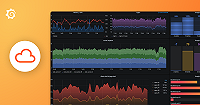Important: This documentation is about an older version. It's relevant only to the release noted, many of the features and functions have been updated or replaced. Please view the current version.
Node.js
Enhance your Node.js application’s performance with our Node.js Profiler. Seamlessly integrated with Pyroscope, it provides real-time insights into your application’s operation, helping you identify and resolve performance bottlenecks. This integration is key for Node.js developers aiming to boost efficiency, reduce latency, and maintain optimal application performance.
Note
Refer to Available profiling types for a list of profile types supported by each language.
Before you begin
To capture and analyze profiling data, you need either a hosted Pyroscope OSS server or a hosted Pyroscope instance with Grafana Cloud Profiles (requires a free Grafana Cloud account).
The Pyroscope server can be a local server for development or a remote server for production use.
Add Node.js profiling to your application
To start profiling a Node.js application, you need to include the npm module in your app:
npm install @pyroscope/nodejs
# or
yarn add @pyroscope/nodejsConfigure the Node.js client
Add the following code to your application:
const Pyroscope = require('@pyroscope/nodejs');
Pyroscope.init({
serverAddress: 'http://pyroscope:4040',
appName: 'myNodeService'
});
Pyroscope.start()Note
If you’d prefer, you can use Pull mode using Grafana Alloy (recommended) or Grafana Agent (legacy).
Configuration options
Add profiling labels to Node.js applications
Static labels
You can add static labels to the profiling data. These labels can be used to filter the data in the UI and apply for all profiles collected. Common static labels include:
hostnameregionteam
Pyroscope.init({
serverAddress: 'http://pyroscope:4040',
appName: 'myNodeService',
tags: {
region: ENV['region']
},
});
Pyroscope.start()Dynamic labels for Wall/CPU profiles
In Wall/CPU profiles, labels can also be attached dynamically and help to separate different code paths:
Pyroscope.wrapWithLabels({ vehicle: 'bike' }, () =>
slowCode()
);Send data to Pyroscope OSS or Grafana Cloud
Pyroscope.init({
serverAddress: 'http://pyroscope:4040',
appName: 'myNodeService',
tags: {
region: ENV['region']
},
basicAuthUser: ENV['PYROSCOPE_BASIC_AUTH_USER'],
basicAuthPassword: ENV['PYROSCOPE_BASIC_AUTH_PASSWORD'],
// Optional Pyroscope tenant ID (only needed if using multi-tenancy). Not needed for Grafana Cloud.
// tenantID: ENV['PYROSCOPE_TENANT_ID'],
});
Pyroscope.start()To configure the Node.js SDK to send data to Pyroscope, replace the serverAddress placeholder with the appropriate server URL. This could be the Grafana Cloud Pyroscope URL or your own custom Pyroscope server URL.
If you need to send data to Grafana Cloud, you’ll have to configure HTTP Basic authentication. Replace basicAuthUser with your Grafana Cloud stack user ID and basicAuthPassword with your Grafana Cloud API key.
If your Pyroscope server has multi-tenancy enabled, you’ll need to configure a tenant ID. Replace tenantID with your Pyroscope tenant ID.
Troubleshoot
Setting DEBUG env to pyroscope provides additional debugging information.
DEBUG=pyroscope node index.js

